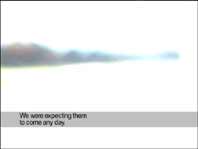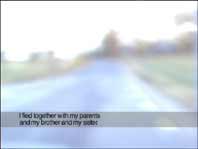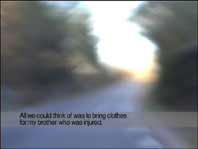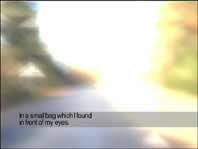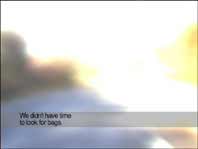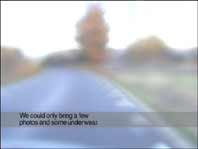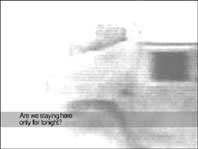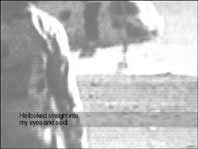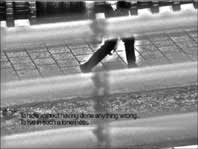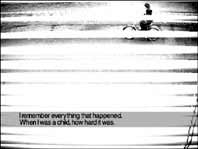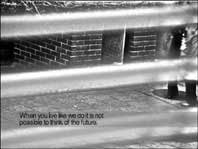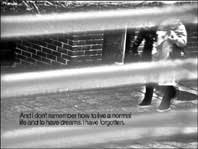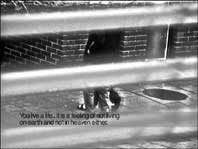Meanwhile,
butterflies flutter from flower to flower; aeroplanes fly between airports.
As in the natural world, strategies of invisibility and deception are
at work in the systems of human migration too. In the interiors of airport
terminals, anonymous doors and corridors guide asylum seekers out of
sight from other passengers. Severe fines for bringing asylum seekers
without proper visa documents to the borders of Schengen countries,
such as Sweden, impel travel and transport companies to set up preventive
control mechanisms already in the places of departure. Thus, the execution
of Swedish immigration policies is removed outside the Swedish horizon,
in-visualised and transferred into the hands of commercial agents.
Whitin
the national borders, in contrast to the above-mentioned strategies,
a wide range of tactics of invisibility are implemented on a daily basis.
Around a thousand persons are now in Sweden hiding away from expulsion;
together, they equal the population of a small provincial town, but
they are scattered and in concealment, dispersed and in constant flux.
For them, and for those who hide them, all the small ways in which a
person is seen, gets noticed, marks a space as her own, occupies the
gaze of another; all those small instances of recognition, which usually
confirm the person, instead threaten her existence. Risk situations
and tactics of circumvention are plural. The risk of washing and drying
one’s clothes in common laundries. Avoiding to buy food in the
same store too often. The anxiety of travelling by train, or of going
to the hairdresser; situations where one is simultaneously exposed and
not free to move. Children, of course, involve particular problems:
to provide education, to constantly weigh their need for friends against
the danger that they may confide in friends too much. To change residence
again and again, at short notice, and to always cautiously clean up
after oneself.
The
Swedish artist Anna Brag approaches these experiences in her video work
No man … an Island. Its basis is a long conversation between the
artist and a woman of her own age, who for two years now has been in
Sweden hiding away from expulsion to her war-ravaged native country.
To document a person who is dependent on invisibility necessarily involves
a careful balance between representing and concealing. Only the sound
of the woman’s voice, not the image of her face, is presented to
the beholder. Her image, as well as markers of any recognisable location,
are withheld by an evasive camera-eye, whose blurry focus glides across
seemingly neutral surfaces: kitchen cupboards, garden flowers, a Venetian
blind… As the woman’s words grow into an anonymous but straightforward
account of her experiences before, during and after her migration to
Sweden, the viewer must wonder whether the camera eye actually represents
the woman’s gaze or perhaps his own.
Of
course, Brag’s work requires that a trust be established between
the artist and the (un)portrayed, since both must contribute to the
necessary invisibility. Their encounter had to be preceded by a number
of discrete inquiries to build confidence. Finally, it is only the renunciation
of facial portraiture that permits these experiences to be laid bare.
Conversely, for every non initiated meeting this woman face to face,
she must be silenced, covered-up behind what may appear as a mask of
everyday normality. Behind that mask, however, as anyone who listens
to the voice in Brag’s work becomes acutely aware of, is hidden
no exclusive knowledge, no treasure or crime, which in itself would
motivate hiding. Instead, we are told precisely the opposite –
of an everyday existence, mirroring our own, lacking in any mysterious
quality or essence. Indeed, if we were to speak here about two different
texts – one visible (mask) and one hidden (face) – there would
be no discernible difference between them. The display of mimicry and
camouflage, thus, is not brought about by the existence of a secret,
but by the contingencies of immigration policy, asylum criteria, and
political will. Or, to put it differently, because someone doesn’t
want her to live here.
Roland
Barthes once imagined that there might be, somehow, a new science for
each object, a mathesis singularis (instead of the traditional universalis).
Could there also be a unique statistics for each and every one of us,
incomparable to everyone else’s – no more “we” or
“they”? Absurd as this fantasy is, ruling out categories of
nationality, ethnicity, etc., it may serve as counterweight to fantasies
of “us” – exclusive or inclusive. One of the discourses
on immigration, that of multiculturalism, is not unlike the poetics
of butterflies on flowery meadows: nomadic and exotically colourful
creatures pollinate their environment, thereby enriching it with aromatic
flowers – which would be, I suppose, the pizzas and chorizos. Both
fantasies also include a motif of complete transformation: as the anonymous
caterpillar turn into a wonderful butterfly, the immigrant becomes her
culture first at her arrival to the new, free country. As many have
pointed out, the totalitarian element in multiculturalism consists precisely
in this frictionless reduction of the individual to a mere function
of culture. Here, “we” are united, as in an edenic garden
where all animals are allowed to live, through the supposition that
“your culture is to you as my culture is to me”.
What
is lacking in that vision, however, is – besides that paradises
tend to be heavily guarded – the inescapable discrepancy between
any subject and “its” national or cultural identity. It lacks
UV reception; it is blind to that other text, which is always written
across and against such inclusive definitions, and visible only to a
secret, personal gaze, but never to bureaucracy. Brag’s video work,
blurry and undetermined – is the woman Kosova, Iraqi or Colombian?
– brings into focus precisely that split between individual existence
and discursive determination of identity, always forced upon the subject
from outside. In such violent conflicts, as the one from which this
woman has fled, that existential dilemma becomes acute. A PUT (as the
abbreviation for permanent residence permit is spelled in Swedish) would
resolve neither the dilemma, nor the conflict, but simply acknowledge
the right of an Other to live and to be partly seen.


